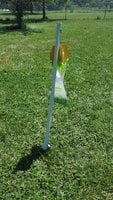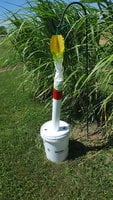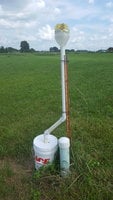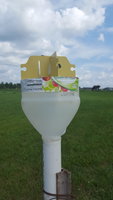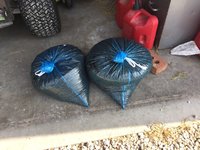These little buddies of many in the midwestern US do not need much of an introduction other than not much good can be said about them if you are interested in horticulture.
I am gearing up for an experiment that might be of interest to some. We spend a lot of effort trying to keep Japanese Beetles off blueberry and elderberry crops resulting in the capture of many hundreds of pounds of beetles. Catching them in mass is easy once you figure out how to trap them. We froze them in mass. Now we are experimenting in ways to make feed from them. First round involved simply feeding them out. Fish and chickens really like them but they are too bulky for storage and rot quickly. Second round involved running frozen beetles through a meat grinder. Fish and birds hammered them even better and the ground beetles could be stored in a much tighter space. The moisture is the problem preventing more economical long-term storage. We playing around now with drying the beetles out in a convection oven which is going to greatly improve shelf life. We preparing about 20 lbs of dried beetles for feeding out to fish and some will be sidelined to chickens. That going chickens will be mixed into a scratch to seriously increase protein levels. Should make the mix look pretty. Most the dried product will be subjected to milling to see how it compares to wet frozen product.
![20180225_063006[1].jpg 20180225_063006[1].jpg](https://www.backyardchickens.com/attachments/20180225_063006-1-jpg.1275704/)
![20180225_063013[1].jpg 20180225_063013[1].jpg](https://www.backyardchickens.com/attachments/20180225_063013-1-jpg.1275707/)
Care must be taken to control smells. We have already been run out of one building. After drying I think smells will be OK for most.
I am gearing up for an experiment that might be of interest to some. We spend a lot of effort trying to keep Japanese Beetles off blueberry and elderberry crops resulting in the capture of many hundreds of pounds of beetles. Catching them in mass is easy once you figure out how to trap them. We froze them in mass. Now we are experimenting in ways to make feed from them. First round involved simply feeding them out. Fish and chickens really like them but they are too bulky for storage and rot quickly. Second round involved running frozen beetles through a meat grinder. Fish and birds hammered them even better and the ground beetles could be stored in a much tighter space. The moisture is the problem preventing more economical long-term storage. We playing around now with drying the beetles out in a convection oven which is going to greatly improve shelf life. We preparing about 20 lbs of dried beetles for feeding out to fish and some will be sidelined to chickens. That going chickens will be mixed into a scratch to seriously increase protein levels. Should make the mix look pretty. Most the dried product will be subjected to milling to see how it compares to wet frozen product.
Care must be taken to control smells. We have already been run out of one building. After drying I think smells will be OK for most.




